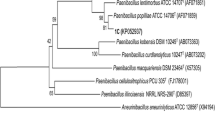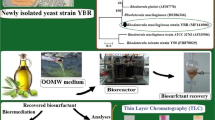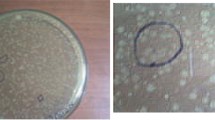Abstract
A biosurfactant producing strain was isolated and the rhamnolipid type biosurfactant was extracted for soil washing of a synthetically and naturally hydrocarbon-contaminated soil. Following the primary screening, Pseudomonas aeruginosa strain R4 was selected and the effect of the carbon and nitrogen source and the salinity on biosurfactant production was studied. Of the best results were observed for glucose as a carbon source, NH4Cl as a nitrogen source and salinity of 1.4%. The produced biosurfactant was a glycolipid type biosurfactant and reduced the surface tension to 32.5 mN/m with a critical micelle concentration (CMC) of 50 mg/L and production yield of 90 mg/L. Using produced biosurfactant, a pyrene desorption rate of 82% was observed in selected conditions for initial pyrene concentration of 200 mg/L.











Similar content being viewed by others
References
Abdel-Shafy HI, Mansour MS. A review on polycyclic aromatic hydrocarbons: source, environmental impact, effect on human health and remediation. Egypt J Pet. 2016;25(1):107–23.
Bento FM, Camargo FA, Okeke BC, Frankenberger WT. Comparative bioremediation of soils contaminated with diesel oil by natural attenuation, biostimulation and bioaugmentation. Bioresour Technol. 2005;96:1049–55.
Ravindra K, Sokhi R, Van Grieken R. Atmospheric polycyclic aromatic hydrocarbons: source attribution, emission factors and regulation. Atmos Environ. 2008;42:2895–921.
Freire C, Abril A, Fernández M, Ramos R, Estarlich M, Manrique A, et al. Urinary 1-hydroxypyrene and PAH exposure in 4-year-old Spanish children. Sci Total Environ. 2009;407:1562–9.
Guo C, Zhou H, Wong Y, Tam N. Isolation of PAH-degrading bacteria from mangrove sediments and their biodegradation potential. Mar Pollut Bull. 2005;51:1054–61.
Kiran GS, Thomas TA, Selvin J. Production of a new glycolipid biosurfactant from marine Nocardiopsis lucentensis MSA04 in solid-state cultivation. Colloids Surf. B. 2010;78:8–16.
U.S. EPA. T. t. f. s. c. a. s. r. O., and of solid waste and emergency response. 10th ed; 2001.
Urum K, Grigson S, Pekdemir T, McMenamy S. A comparison of the efficiency of different surfactants for removal of crude oil from contaminated soils. Chemosphere. 2006;62:1403–10.
Urum K, Pekdemir T, Gopur M. Optimum conditions for washing of crude oil-contaminated soil with biosurfactant solutions. Process Saf Environ. 2003;81:203–9.
Urum K, Pekdemir T, Çopur M. Surfactants treatment of crude oil contaminated soils. J Colloid Interf Sci. 2004;276:456–64.
Ilori M, Amobi C, Odocha A. Factors affecting biosurfactant production by oil degrading Aeromonas spp. isolated from a tropical environment. Chemosphere. 2005;61:985–92.
Mehdi H, Giti E. Investigation of alkane biodegradation using the microtiter plate method and correlation between biofilm formation, biosurfactant production and crude oil biodegradation. Int Biodeterior Biodegrad. 2008;62:170–8.
Saeki H, Sasaki M, Komatsu K, Miura A, Matsuda H. Oil spill remediation by using the remediation agent JE1058BS that contains a biosurfactant produced by Gordonia sp. strain JE-1058. Bioresour Technol. 2009;100:572–7.
Varjani SJ, Upasani VN. Critical review on biosurfactant analysis, purification and characterization using rhamnolipid as a model biosurfactant. Bioresour Technol. 2017;232:389–97.
Jorfi S, Rezaee A, Moheb-ali G-a, alah Jaafarzadeh N. Pyrene removal from contaminated soils by modified Fenton oxidation using iron nano particles. J Environ Health Sci. 2013b;11:17.
Gaskin S, Bentham R. Comparison of enrichment methods for the isolation of pyrene-degrading bacteria. Int Biodeterior Biodegradation. 2005;56:80–5.
Jorfi S, Rezaee A, Mobeh-Ali G-A, Jaafarzadeh NA. Application of biosurfactants produced by Pseudomonas aeruginosa SP4 for bioremediation of soils contaminated by pyrene. Soil Sediment Contam. 2013a;22:890–911.
Nayak AS, Vijaykumar M, Karegoudar T. Characterization of biosurfactant produced by Pseudoxanthomonas sp. PNK-04 and its application in bioremediation. Int Biodeterior Biodegradation. 2009;63:73–9.
Adebajo S, Akintokun A, Bolaji S. Biosurfactants producing bacteria from oil-polluted soil in Abeokuta, Ogun state. IFE J Sci. 2018;20:287–97.
Lotfabad TB, Shourian M, Roostaazad R, Najafabadi AR, Adelzadeh MR, Noghabi KA. An efficient biosurfactant-producing bacterium Pseudomonas aeruginosa MR01, isolated from oil excavation areas in south of Iran. Colloids Surf. B. 2009;69:183–93.
Darvishi P, Ayatollahi S, Mowla D, Niazi A. Biosurfactant production under extreme environmental conditions by an efficient microbial consortium, ERCPPI-2. Colloids Surf B. 2011;84:292–300.
Talaie AR, Talaie MR, Haghighifar NJ. Optimizing biodegradation of floating diesel fuel contaminated wastewater using the Taguchy method. J Water Wastewater. 2009;20:57–68.
Assadi T, Bargahi A, Nabipour I, Mohebbi GH, Kholdebarin B, Mohajerani S, et al. Determination of fatty acid composition of halophyte plant (Suaeda vermiculata) collected from the shorelines of Persian gulf region (Bushehr Province). ISMJ. 2014;17:638–46.
Adamczak M, odzimierz Bednarski W. Influence of medium composition and aeration on the synthesis of biosurfactants produced by Candida antarctica. Biotechnol Lett. 2000;22:313–6.
Robert M, Mercade M, Bosch M, Parra J, Espuny M, Manresa M, et al. Effect of the carbon source on biosurfactant production byPseudomonas aeruginosa 44T1. Biotechnol Lett. 1989;11:871–4.
Bezza FA, Chirwa EMN. Biosurfactant from Paenibacillus dendritiformis and its application in assisting polycyclic aromatic hydrocarbon (PAH) and motor oil sludge removal from contaminated soil and sand media. Process Saf Environ. 2015;98:354–64.
Sousa M, Melo V, Rodrigues S, Sant’ana H, Gonçalves L. Screening of biosurfactant-producing Bacillus strains using glycerol from the biodiesel synthesis as main carbon source. Bioprocess Biosyst Eng. 2012;35:897–906.
Ayed HB, Jemil N, Maalej H, Bayoudh A, Hmidet N, Nasri M. Enhancement of solubilization and biodegradation of diesel oil by biosurfactant from Bacillus amyloliquefaciens An6. Int Biodeterior Biodegradation. 2015;99:8–14.
Yin H, Qiang J, Jia Y, Ye J, Peng H, Qin H, et al. Characteristics of biosurfactant produced by Pseudomonas aeruginosa S6 isolated from oil-containing wastewater. Process Biochem. 2009;44:302–8.
Joshi S, Bharucha C, Desai AJ. Production of biosurfactant and antifungal compound by fermented food isolate Bacillus subtilis 20B. Bioresour Technol. 2008;99:4603–8.
Abouseoud M, Maachi R, Amrane A, Boudergua S, Nabi A. Evaluation of different carbon and nitrogen sources in production of biosurfactant by Pseudomonas fluorescens. Desalination. 2008;223:143–51.
Acknowledgments
This paper was issued from the thesis of Forud Niyazi under grant number ETRC-9526. Special thanks to Ahvaz Jundishapur University of Medical Sciences for their supports in conducting the current research.
Author information
Authors and Affiliations
Corresponding author
Ethics declarations
Conflict of interest
The authors declare that they have no conflict of interest.
Additional information
Publisher’s note
Springer Nature remains neutral with regard to jurisdictional claims in published maps and institutional affiliations.
Rights and permissions
About this article
Cite this article
Ahmadi, M., Niazi, F., Jaafarzadeh, N. et al. Characterization of the biosurfactant produced by Pesudomonas areuginosa strain R4 and its application for remediation pyrene-contaminated soils. J Environ Health Sci Engineer 19, 445–456 (2021). https://doi.org/10.1007/s40201-021-00617-w
Received:
Accepted:
Published:
Issue Date:
DOI: https://doi.org/10.1007/s40201-021-00617-w




